आलू के बीज की गुणवत्ता - आलू उत्पादन का अभिन्न अंग
High yields of potato revolve around use of high-quality seed potatoes. Access to quality seed to end users is the main requirements for bridging significant yield gaps for potatoes. Genetic purity, sound physiological age, disease free, proper seed size and free from internal/ external damage are the major parameters of quality seed potato tuber.
Cultivar, soil type, weather conditions, water management, plant population, seed piece size, pests and diseases and agricultural management practices from seedbed preparation to storage, i.e., tillage, planting, pest management, haulm killing and harvesting affect the quality seed potato tuber production.
Seed potato quality is ensured by seed certification process by seed certification agencies of state government. Grow out test is performed to determine germination, morphological characters and incidence of viruses to ascertain their genetic purity of a given seed lot of released cultivars for quality control.
Significance of quality seed in potato
The quality of seeds is considered an important factor for increasing yield and helps greatly in higher production per unit area to attain food security of the country. Quality seeds have the ability for efficient utilization of the inputs such as fertilizers and irrigation. Like other crops, high yields of potato (Solanum tuberosum L.) revolves around use of high-quality seed potatoes.
Since potato is a vegetatively propagated plant, fungal, bacterial and especially viral diseases easily affect seed tubers quality which is responsible for fast degeneration, requiring seed replacement after every four years. Additionally, the quality seed is either unavailable or out of the reach of poor farmer owing to high seed cost /violent price fluctuations.
The seed related issues are further intensified due to restricted accessibility to seed producing regions, difficulties in the production and distribution of disease free seeds, transportability of quality seeds and inadequacies of cold storage facilities resulting in rotting and sprouting.
One major constraint resulting in lower productivity of potato in the country is the use of poor-quality seed. So it is essential to ensure quality seed potato availability within farmer’s reach at a reasonable price.
Good quality seed is almost universally considered a requirement for high productivity in all potato production systems. Potato seed sector development is thus a major concern of governments, researchers, development agencies, and civil society organizations.
Selecting and planting clean, disease-free potato good quality seed is the first step to a successful crop production for potato growers. Seed multiplication rate in potato is only 1:6 and production cost is very high due to stringent quality control.
Seed production is very technical aspect and needs careful attention during all stages like date of planting, spacing, fertilization, top-dressing, irrigation, roguing, weeding, earthing up, spraying of pesticides, date of dehaulming, harvesting, etc.
Quality of seed potato is important for good yield therefore seed production; harvesting (dehaulming and harvesting) and storage should be carefully carried out as per standard seed plot technique. The average yield increase from the use of good quality seed is 30 to 50 percent compared to farmers’ seeds.
The seed accounts for 30 to 70% of the total production cost depending on the country or region and in India, it ranges from 40 to 50%. Seed tuber is the single most important factor in potato cultivation and if the seed does not possess good qualities, then optimum production can not be achieved.
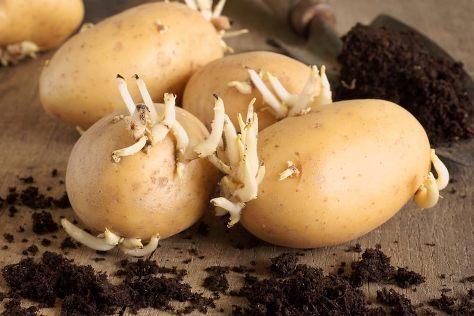
Healthy/quality seed tuber
Access to high-quality seed potatoes
Access to quality seed is widely considered one of the main requirements for bridging significant yield gaps for potatoes. The production of elite seeds such as pre-basic and basic potato is in charge of public and private institutions with infrastructure and laboratories for the accelerated multiplication of potato cultivars with the highest demand in the market.
Generally, the maintenance and management of a seed program involves high costs because it is a highly specialized activity. In many developing countries, these functions are often performed by public sector breeding programs.
For this reason, the producers of seeds of certified, authorized and declared categories depend on the operational and logistic capacity of the institutions or companies that produce the pre-basic and basic seeds. Delays in the availability of adequate quantity and quality of seeds can cause large bottlenecks in the production of quality seeds.
Therefore, it is necessary to promote the establishment of agreements or contracts between seed producer organizations and public improvement programs that establish commitments to deliver seeds with quantity, quality and punctuality.
Likewise, it is necessary to strengthen the capacities of producers and users of quality seeds with training methodologies where knowledge is gained through participatory and experiential practices. High transaction costs, lack of a clear seed delivery systems and imperfect information on source of seed limit accessibility to quality seed.
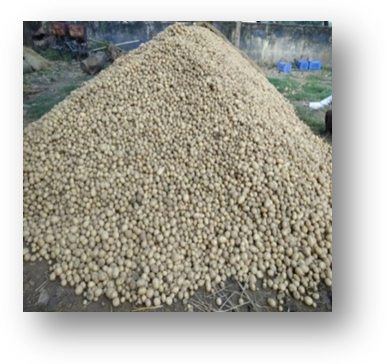 |
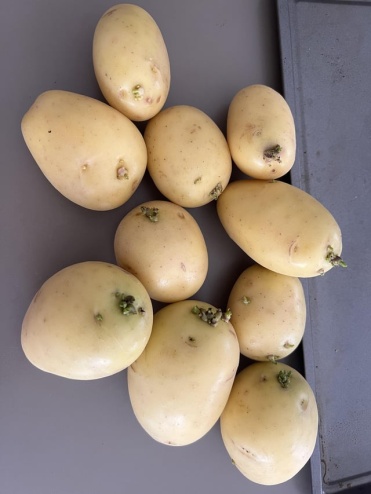 |
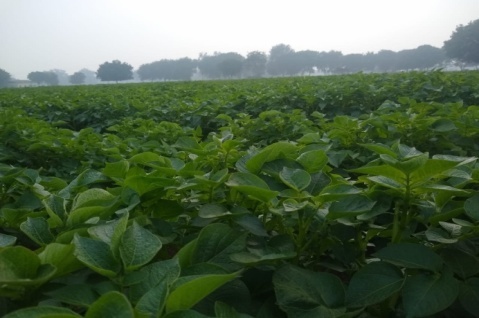 |
|
Healthy seed production under SPT |
Seed tuber sprouting |
Potato crop from quality seed |
Seed potato quality parameters
Many factors determining yield are affected by seed quality. Good quality seed is obtained when the seed tubers are harvested on a seed field in good condition. Quality tuber seed should be able to produce healthy and vigorous plants within the growing season. Seed quality is determined by the following parameters
Genotype/ varietal purity:
Seed must be of true variety and should not have different varieties or mutants. The genotype determines tuber number, tuber size, tuber mass and yield potential for any given cultivar. A batch of seed potatoes with true to type genotype manifests in a large canopy and exhibits homogeneous growth in the early stages of its development.
Seed tubers of the same potato genotype that were produced in different production fields can display significant differences in their vitality, resulting in differences in growth of the emerging potato plants.
Biological quality
Physiological age/ maturity:
At planting, seeds should be physiologically mature with multiple vigorous sprouts. This kind of seed tubers germinate rapidly and develop several stems. Physiological age refers to the state of the seed tuber at any time and is defined as the stage of development of a seed tuber as it progresses through time depending on conditions during growth and storage and as it affects its vigor when planted. The size of the seed tuber determines to some extent the number of eyes present, the proportion of the eyes producing one or more sprouts, and the proportion of the sprouts producing a stem, thus determining the final number of stems developing per seed tuber. The size of a seed tuber has an impact on the development of the physiological age, while the physiological age also has its direct impact on the proportion of eyes producing one or more sprouts and the proportion of sprouts producing a stem, thus also determining (in close interaction with seed tuber size) the number of stems produced by a single seed tuber. Physiological age is determined by genotype, chronological age and environmental conditions from tuber initiation until new plant emergence or the stage of development of a tuber, which is modified progressively by increasing chronological age, depending on growth history and storage conditions.
Understanding dormancy and sprouting characteristics in seed potato is crucial which is associated with variety and seed origin. Dormancy is the physiological state of the tubers in which tubers do not sprout even when placed in ideal germination conditions. The dormancy period varies from 2 to 4 months depending on genotype and pre and post-harvest conditions. The vigour of potato is dependent on the physiological potential during establishment, emergence and development of plants. The plant vigour is an important aspect since it determines the materials future productivity that is conditioned genetically, physiologically and ecologically.
Healthy tuber / the level of disease infection:
Tuber seeds must be free of disease and the percentage of infected tubers in the seed lot must be below locally accepted standards. Seeds devoid of diseases and parasites are obtained from tubers that themselves were devoid of them. It is well known that seed tubers planted continuously for several years will show degeneration. The degeneration is aroused by several kinds of viruses and virus-like organisms. Because of asexual propagation, viruses and viroids can be accumulated in tubers, and lead to degeneration of the potato. Major viruses affecting the potato are potato virus Y (PVY), potato virus X (PVX), potato virus M (PVM), potato virus A (PVA), potato leaf roll virus (PLRV) and potato spindle tuber viroid (PSTV). Infection of any one alone or some of them jointly would retard plant growth and reduce tuber yield. Apart from viruses, fungal and bacterial pathogens borne by tubers lead to late blight, ring rot, black-leg and others, and are also limiting factors for seed quality.
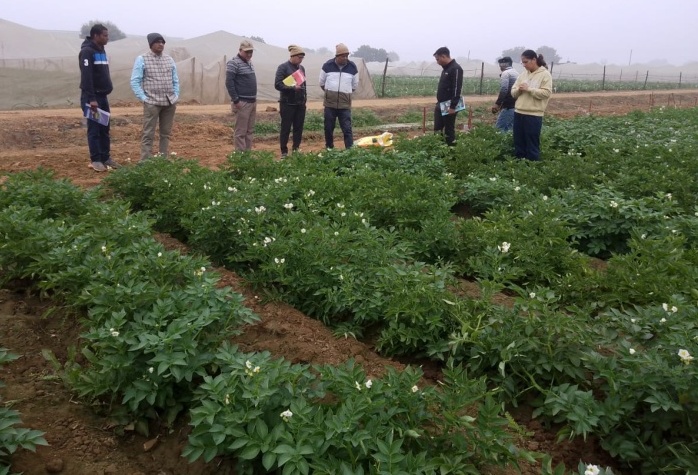
Internal seed health monitoring by ICAR-CPRI
Commercial quality
Commercial quality is defined by uniformity and size of tubers, as well as external appearance. For normal production, a reasonable size of seed tuber or tuber pieces should be about 40 to 50 grams. Big size seed will increase cost and seed that are too small can rot before emergence.
Seed tuber Size: The size of a seed lot will need to be homogeneous to ensure consistent germination and development. Size of seed tuber is an important factor to decide the seed per unit area because it affects total yield and graded or marketable tuber yields. Seed rate depends on the size of tubers used in planting for ware as well as seed crop. Standard seed tuber of 25–125 g weight (30–55mm) is rated as seed size tubers in India table 1 (IMSCS, 2013).
Appropriate seed tuber size has very important implication on potato production. The number of sprouts that develop from a seed tuber is influenced by the size of seed tuber. In larger tubers, growth is faster because of greater food reserve availability for each sprout and generally produce more sprouts which may result in the production of too many stems and eventually produce too many tubers.
If larger seed is used, a greater quantity of seed is required for planting per unit area. It is avoided because it increases seed costs and reduce planter’s accuracy. Conversely, smaller seed size tubers have less sprouts per unit due to the lesser amount of reserves available for sprout growth leading to small number of stems that produce only a few tubers, thereby reducing yield.
Big size seed will increase cost and seed that are too small may rot before emergence. The plantable tuber size for potato production is 40–50g for gaining maximum production potential from field. Small and medium size seed tubers are preferred by farmers engaged in small scale cultivation to reduce seed cost.
Many factors determine tuber size distribution such as number of stems per plant and the rate of crop growth which are difficult to manipulate. One of the most controllable factors is seed size. Low variation of tuber size is desirable in seed potato production.
Table 1. Seed standards for hill and plain grown seed tubers
|
Type of seed |
Grade |
Size (mm) |
Corresponding weight (g) |
|
Hill seed |
Seed size |
30–60 |
25–150 |
|
Large |
Above 60 |
Above 150 |
|
|
Plains seed |
Seed size |
30–55 |
25–125 |
|
Large size |
Above 55 |
Above 125 |
Physical defect/ external appearance:
Seeds must be free from external damage that could occur during harvesting or during post-harvest treatment that could make tubers vulnerable to bacteria, fungi and parasites, and thus increase the risk of low germination and growth. Seeds should also be free from any internal damage caused by poor growing and storage conditions. This can increase vulnerability to diseases. They shall be substantially dry outside and, in general, of normal shape for the variety.
Factor influencing seed quality
Factors that influence potato seed quality include cultivar, soil type, weather conditions, water management, plant population, seed piece size, pests and diseases and agricultural management practices from seedbed preparation to storage, i.e., tillage, planting, pest management, haulm killing and harvesting are extremely important for healthy seed tuber production.
Low tolerance to diseases, damaged tubers and varietal mixtures negatively affect the production of high-quality seed potatoes. The use of healthy seeds, altitude of the production area, experience of producers and agricultural practices adopted for the production of seed potato significantly improve quality.
Healthy seed tubers could be produced by ensuring proper disease management in the cultivation area. Vegetative propagation of the same stocks used year after year results in cumulative infiltration of pathogens, particularly the prevalent viruses which spread both through contact and aphid/ vectors. Further infection of viruses has strong devitalizing effect bringing down the yield potential of the infected plants/ crop.
It has also been observed that loss in yield following virus infection is genotype/variety specific. The varieties react with different degrees of loss in tuber yield depending on the virus (es)/ stage of infection, and period of field exposure of the seed stocks The degeneration and consequent losses in yield vary in different potato growing regions.
The other determinant such as fertilizer, manure, and agrochemicals affect the plant’s health and the output from the crop. Harvesting method is also critical in determining the quality of potatoes. Bruised potatoes have a low shelf life and are not preferred by consumers.
After harvesting, potatoes are sorted for packaging. Storage condition is critical in maintaining good quality potatoes. Dark cold storage at 3-40C prevents the potatoes from sprouting and changing color and helps maintain freshness. Finally, transport method can also affect quality. Transporting using recommended bags or packages reduce the chances of bruising and damage from sunlight.
Seed certification
Certification of seed potato tubers is essential so as to ensure seed quality and prevent seed degeneration as well as spread of pests and diseases. Seed certification is managed by Central Seed Certification Board through ‘Seed Act’ which provides a set of rules for regulation of quality and purity of the seed material.
The rules framed by the Central Seed Certification Board are followed by the State Seed Certification Agencies for carrying out the certification. The responsibility for the quality standards of seed that enters the trade market lies with the state seed certification agencies.
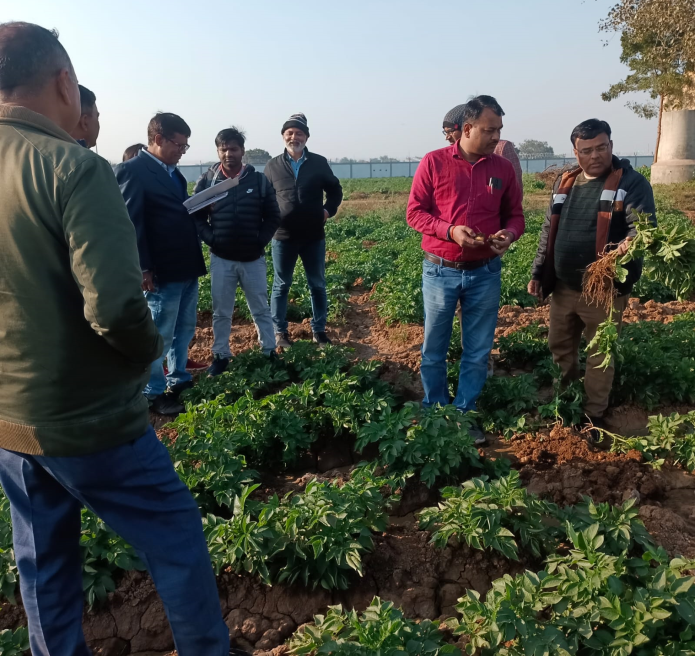
Seed monitoring by Seed Certification Agency
Quality control
Quality control test is done to determine the genetic purity of a given seed lot of released cultivars and the extent to which the given sample confirms to the prescribed standards. The samples for grow out test is to be drawn simultaneously by the seed supplier and the seed recipient by following the standard procedure.
In a lot of 100 q, 250 seed potato tubers are drawn along with tag having details of source of seed, variety and lot number. Grow out test is performed by growing the sample seed tubers in the next crop season as per standard package of practices. During this test, observation on germination, morphological characters and incidence of viruses are recorded to ascertain their genetic purity.
Conclusion
Production of high quality seed with higher genetic purity, sound physiological age, disease free, proper seed size and free from internal/ external damage with standard seed plot technique is of most importance and its access to end users is the main requirements for bridging significant yield gaps under potato system.
References
- Anonymous, 2015. Annual report 2014-15. ICAR-Central Potato Research Institute, Shimla, India: 82 pp.
- Khalafalla, A. M. 2001. Effect of plant density and seed size on growth and yield of Solanum potato in Khartoum state, Sudan. African Crop Science Journal Vol. 9, No. 1: pp. 77-82.
- Hudaa, M.S., , Islamb, M. R., Hannanc, A., Islamd, S., Hossain S.M.M., 2021. Seed quality assessment of farmer’s produced seed potato. Plant Physiology and Soil Chemistry (PPSC) 1(2) 41-44
- Singh, R. K, Buckseth, T. Sharma, A K., Tiwari J K and Chakrabarti S K (2019) Potato seed certification in India. Indian Horticulture 16:6-54-58
- Singh, R .K. and Buckseth, (2024). Agro-techniques for quality seed potato production Indian Farming 74 (05): 12-15;
- Virtanen, E., and Seppa¨nen M. 2014. Effects of haulm killing on seed potato quality. Journal of Agricultural Science, 6(3), 168.https://doi.org/10.5539/jas.v6n3p168 7.
- Yılmaz, G. 2003. Determination of Some Yield and Yield Properties of Seed Potato (Solanum tuberosum L.) Tubers in Different Classes. Turkish-Coop. Ekin Journal 26: 26–32, Ankara. (in Turkish).
Authors:
Murlidhar J Sadawarti1, SP Singh2, Subhash Katare1, Tanuja Buckseth3, Vinod Kumar3, Rajesh K Singh4, Priyadarshani Khambalkar5, RK Samadhiya1, YP Singh1, SK Sharma,1 Surender Singh1 and Brajesh singh3
1ICAR-Central Potato Research Institute, Regional Station, Gwalior-474 020 MP, India
2ICAR-Central Potato Research Institute, Regional Station, Patna 801506 Bihar, India
3ICAR-Central Potato Research Institute, Shimla-171001 HP, India
4ICAR-Central Potato Research Institute, Regional Station, Modipuram Meerut-250 110 UP, India
5 Rajmata Vijaya Raje Scindia Krishi Vishwa Vidyalaya, Gwalior- 474 020 MP, India
Corresponding author:
